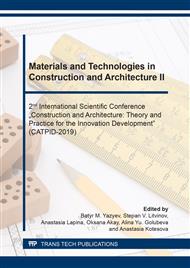p.237
p.243
p.249
p.255
p.261
p.267
p.273
p.277
p.283
Study of the Carbonate Component Raw Material Mixture Effect on the Clinker Grindability
Abstract:
The carbonate components effect of raw materials - chalk and limestone on the clinker properties has been determined. Studies have been carried out on the raw mix these components partial replacement with the Oskol electrometallurgical plant slag in the amount of 10 and 20%. The maximum decrease in the carbonate component amount was 10%. The grinding clinker individual stages, characterized by the material destruction certain processes have been analyzed. It has been established that by reducing the chalk content in the raw mix and replacing it with the Oskol electrometallurgical plant slag, the clinker grindability is improved. The duration of grinding of such clinker is reduced by 22%. A decrease in the limestone amount in the raw mix and an increase in the Oskol electrometallurgical plant slag content does not affect the synthesized clinkers grindability.
Info:
Periodical:
Pages:
261-266
Citation:
Online since:
December 2019
Price:
Сopyright:
© 2020 Trans Tech Publications Ltd. All Rights Reserved
Share:
Citation:


